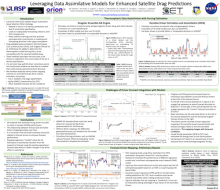Leveraging Data Assimilative Models for Enhanced Satellite Drag Predictions
Marcin
Pilinski
University of Colorado, Boulder, Laboratory for Atmospheric and Space Physics
Poster
Low Earth Orbit (LEO) satellite drag is a persistent Space Weather (SWx) challenge requiring urgent and immediate attention. One of the main impediments to accurate satellite drag predictions results from uncertainties in the air density of the highly-variable upper atmosphere, also known as the thermosphere. In-turn, this thermospheric variability is primarily driven through forcing by dynamic solar wind and extreme ultraviolet radiation. Drag-validated data assimilation (DA) techniques such as IDEA [Sutton 2018], and Dragster [Pilinski et al. 2016] now have the ability to determine the thermospheric model forcing that is most compatible with the observed satellite drag, effectively making a “driver correction” to the atmospheric models at each time step. These methods have been the only ones so far shown to match or outperform the current state of the art in density specification, which is the High Accuracy Satellite Drag Model (HASDM) used by the Department of Defense.
As promising as these driver corrections are, it is not clear how well DA driver corrections persist into the forecast window nor how best to combine them with existing operational driver forecasts. Determining this “driver-mapping” and delivering it to the broader community can enable broader access to forecasts that are tied to our best estimates of the present drag environment. To achieve this outcome, our team is performing a driver-mapping evaluation that tests various approaches for mapping DA-estimated geomagnetic and solar drivers to forecast products. The mapping algorithms that are being evaluated include linear and non-linear regression as well as autoregressive neural network models. The overall goal is to determine how best to make ND forecasts using the best validated and most operationally ready DA techniques.
As promising as these driver corrections are, it is not clear how well DA driver corrections persist into the forecast window nor how best to combine them with existing operational driver forecasts. Determining this “driver-mapping” and delivering it to the broader community can enable broader access to forecasts that are tied to our best estimates of the present drag environment. To achieve this outcome, our team is performing a driver-mapping evaluation that tests various approaches for mapping DA-estimated geomagnetic and solar drivers to forecast products. The mapping algorithms that are being evaluated include linear and non-linear regression as well as autoregressive neural network models. The overall goal is to determine how best to make ND forecasts using the best validated and most operationally ready DA techniques.

Poster PDF
Poster category
Ionosphere and Thermosphere Research and Applications
Poster session day
Poster location
14
Meeting homepage